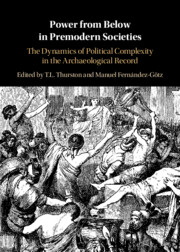 Power from Below in Premodern Societies
Power from Below in Premodern Societies Book contents
- Power from Below in Premodern Societies
- Power from Below in Premodern Societies
- Copyright page
- Contents
- Figures
- Contributors
- Preface
- One Power from Below in the Archaeological Record
- Two Fragmenting Trypillian Megasites
- Three Structure and Agency
- Four Power Requires Others
- Five “And Make Some Other Man Our King”
- Six Societies against the Chief? Re-Examining the Value of “Heterarchy” as a Concept for Studying European Iron Age Societies
- Seven Peasants, Agricultural Intensification, and Collective Action in Premodern States
- Eight The Spread of Scribal Literacy in Han China
- Nine Confronting Leviathan
- Ten The Emergence of Monte Albán
- Eleven Dispersing Power
- Twelve The Perplexing Heterarchical Complexity of New Guinea Fisher-Forager Polities at Contact
- Thirteen Restoring Disorder
- Index
- References
Five - “And Make Some Other Man Our King”
Labile Elite Power Structures in Early Iron Age Europe
Published online by Cambridge University Press: 08 October 2021
- Power from Below in Premodern Societies
- Power from Below in Premodern Societies
- Copyright page
- Contents
- Figures
- Contributors
- Preface
- One Power from Below in the Archaeological Record
- Two Fragmenting Trypillian Megasites
- Three Structure and Agency
- Four Power Requires Others
- Five “And Make Some Other Man Our King”
- Six Societies against the Chief? Re-Examining the Value of “Heterarchy” as a Concept for Studying European Iron Age Societies
- Seven Peasants, Agricultural Intensification, and Collective Action in Premodern States
- Eight The Spread of Scribal Literacy in Han China
- Nine Confronting Leviathan
- Ten The Emergence of Monte Albán
- Eleven Dispersing Power
- Twelve The Perplexing Heterarchical Complexity of New Guinea Fisher-Forager Polities at Contact
- Thirteen Restoring Disorder
- Index
- References
Summary
This excerpt is from the Declaration of Arbroath, which was sent in 1320 with the signatures of 38 Scots noblemen to Pope John XXII in Avignon. The document is an expression of support for Robert I, also known as The Bruce, the leader of one of several competing polities in Scotland in the 14th century. Its other purpose was to petition the pope to persuade the English, led at the time by Edward I, also known as Malleus Scotorum, or “The Hammer of the Scots,” to cease hostilities against Scotland. (To be fair, he hammered the Welsh and diverse infidels in the Holy Land during the Ninth Crusade as well; hammering seems to have been his thing.) The term the Scots nobles used in the Declaration to describe their polity was nacio, usually translated as “the people,” which of course did not mean what it does today – women, children and landless males too old or poor to count were implicitly included but had no actual power over their own persons.
- Type
- Chapter
- Information
- Power from Below in Premodern SocietiesThe Dynamics of Political Complexity in the Archaeological Record, pp. 106 - 124Publisher: Cambridge University PressPrint publication year: 2021
References
- 1
- Cited by
